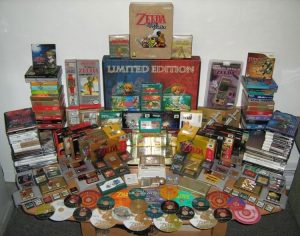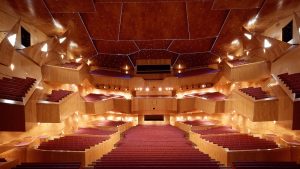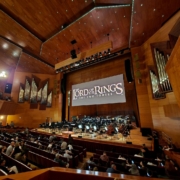Zelda – Symphony of the Goddesses in Bilbao
Nearly everybody knows the name of Zelda, and much of the blame, if not all, is due to Nintendo, as it is one of its most iconic and known saga, along with Mario Bros.
The first game in the Zelda series was released in February 1986, 30 years ago, under the name The Legend Of Zelda, which was later followed by more than 15 games, among which the following could be highlighted; The Adventure of Link (1987), A lInk to the Past (1991), Link’s Awakening (1993), Ocarina of Time (1998), Majora’s Mask (2000), Twilight Princess (2006), Skyward Sword (2011), Tri Force Heroes (2015) or Breath of the Wild, to be released in 2017.
Each of these games, as it happens with a film, has its own music, and Koji Kondo has been the main composer, having the collaboration or having supervised the work of other known Japanese composers like Asuka Ohta, Hajime Wakai, Kenta Nagata, Toru Minegishi or Yuko Takehara, who have been contributing to the musical world of Zelda.
Music has gone accordingly to the characteristics and technical limitations, of the platforms for which the games were published at all times: Famicom Disk System, NES, Super NES, Nintendo 64, Nintendo GameCube, Game Boy Advance, Nintendo 3DS , Wii or Wii-U among others.
Thus, it is not surprising that after so many years and to mark the 25th anniversary in 2011, Nintendo decided to order the creation of a special symphony based on the extensive musical universe of the games of this saga, The Legend of Zelda – Symphony of the Godesses, music that was decided to take in a world tour, which has been repeated almost continuously year after year, including some new features in each new tour.
While last year, 2015, the international tour of The Legend of Zelda – Symphony of the Goddesses stopped in Madrid and Barcelona, this year 2016, as it was already commented here (follow link) a new city was added, Bilbao, for the delight of fans of Zelda in the northern part of the peninsula.
Therefore, on Sunday October 30th and after a short drive, I arrived to the Euskalduna Palace to enjoy the music of Zelda in concert, in an experience that I will relate below.
THE CONCERT
Euskalduna Palace is a multipurpose building designed for both conferences and concerts, with a main auditorium ready for 2,164 people, which has a spectacular design and fabulous acoustics, especially designed to hold this kind of concerts.
Entering through one of the front doors, you could see a big table where t-shirts, posters and an official book of the tour were sold with prices of 10 € or 20 € (the book had brief information about the program, with most of it being piano music sheets from Zelda).
For this concert I chose my seat at the top of the auditorium, in one of the boxes, which had very good views of the stage, and allowed me to contemplate with great detail the interpretations of all the musicians of the orchestra, as well as the curious movements of the stressed members of the percussion section (as I will explain later).
The concert began a little bit later than scheduled, at 7:15pm, with the orchestra, choir and director on stage, greeted with a big applause from the audience. I counted 20 people in the choir (10 male and 10 female), 2 harps located on both sides of the director and immersed in the strings section (that had about 24 pieces in total; violins, violas, cellos and basses), about 8 elements in the woodwinds section and approximately 13 more in the brass section with 4 people on percussion. In total, more than 70 musicians on stage.
The first theme played was Oberture – The Legend of Zelda, where the orchestra strongly introduced the public on the ambience of that night’s concert, while the choir accompanied the piece. Meanwhile, a collection of videos of various games in the Zelda series were projected on a large screen above the stage, interspersed with shots of musicians playing.
Once the piece was finished and after the applause, the producer and promoter of the tour, Jason Michael Paul, came on stage, who addressed the audience in English only, to indicate that the concert in Bilbao was the last concert of the tour in Europe, and that the tour would continue the rest of the year and part of 2017 in the United States and Canada. Then, he left us with a video message in Japanese from Shigeru Miyamoto, the creator of the original game, subtitled in English only (once more). One negative point to consider and that I will address later in the conclusions section.
Next, the moment for the second piece came, Gerudo Valley, a theme with rhythm and energy growing slowly, that did not need the accompaniment of the choir, and that had a very good interpretation.
And now, with the orchestra warmed-up, I could feel something that although did not spoil the concert, was annoying sometimes; the sound of the orchestra was overly amplified, resulting very high for the acoustics provided by the concert hall, and in fact it was not well balanced with the choir, since the choir’s sound was overlapped by the orchestra, and although the female voices section could be heard a little bit, the male voices section hardly could be heard.
But following with the concert, which begun promisingly, the following theme was played Boss Battle Medley, keeping the rhythm and pace of previous Gerudo Valley. This piece was a suite collecting various battle moments against different enemies from different games, with very rhythmic and intense music, which kept the percussion section busy at all times, making their 4 members change and rotate instruments frantically to follow the development of the music. Very good work, both from the percussion and from the rest of the orchestra, that received a huge applause from the audience.
Then the Triforce Heroes Movement was played, which started with a medieval tone and resulted in a very colorful development, giving way to the piece A Link Between Worlds, very interesting both musically and visually, and projecting after its completion a video-message from Eiji Anouma, the producer of the Zelda saga along with Miyamoto, and current head of the saga.
It was time to get into the pieces that properly composed the symphony that gives its name to the concert, The Legend of Zelda – Symphony of the Goddesses, being the first, Prelude – The Creation of Hyrule, which had very mystical and heavenly touches, where the harp helped to create atmosphere, and where I could notice again the amplification and sound problems that I mentioned before; when the harp was playing alone, there was distortion sometimes.
But if we forget about these minor problems, the performance was very enjoyable, and gave way to the first movement of the symphony, that under the title Movement I – Ocarina of Time, had a very strong and dark start, to give way to calm and soft ambience provided by the melodic flutes accompanied by the string section, thus emulating the sweetness of the ocarina, and before reaching the tense finale.
Then came the piece Movement Part II – The Wind Waker, which had musical grace and playfulness, according to what was shown on the screen during its execution, and that received a loud applause at the end.
And so, around 8:15 pm and after 1h of concert, the intermission arrived, lasting about 20 minutes. The second part of the concert continued with the theme Intermezzo – Great Fairy’s Fountain / Song of Time, which gave way to the video-message of the composer of the Zelda saga, Koji Kondo who talked about what Zelda meant to him and his motives and inspirations when composing.
Following, the third movement was interpreted Movement III – Twilight Princess, where again the chorus played a leading role, but the sound did not accompany as desired, to go later into Movement IV – A Link to the Past, where versions of old Zelda games were the protagonists on screen with funny 2D graphics, that were brought alive with the music of the orchestra and the strength of the choir, pulling another good applause from the audience.
The next piece to be interpreted was the official ending of the concert, the Suite from Majora’s Mask, which although started soft, then picked up intensity, and when the final march was reached, the director asked the complicity of the public with their clapping to follow the pace, generating an accomplice and beautiful moment.
The audience was delighted with the concert and fortunately the long final applause encouraged the director and the orchestra to continue for two more themes, Dragon Roost Island and Skyward Sword, a perfect complement to a very good concert.
And so, with another big applause from the audience and the director pointing to each of the sections of the orchestra to say goodbye in different and funny ways, the concert ended at 9:20pm, just over 2 hours after it began.
IN SUMMARY
To end this article, I will begin this section with points that I think could be improved, but always in a positive way:
Language. The initial presentation by the producer of the concert was only in English, and although I think most of the audience understood what he said (or applauded by empathy when he finished his sentences), it would have been a good idea to have someone to do the translation of his speech into Spanish. Same thing happened with video messages that appeared throughout the concert, as they were in Japanese only with English subtitles.
Program. The titles of the pieces played were shown at the end of each block, and not always in a clear way, because sometimes they were integrated into the videos and images of the game (I hope I got them correctly in this article, because it was not easy).
That led to confusion and not really knowing what you were listening, unless you were a hardcore fan of the music of the saga. In addition, with the absence of a one-page summary-program in paper (unless you paid 10 € for a full official program, which was more a piano-book as it was full of scores), I think many people in the audience were not really aware of what was being played at every moment. I think that with a short title shown at the beginning of each piece, this could be easily solved and people would have been less confused.
Occupation. The auditorium was half full at the lower part (stalls and terraced patio), and crowded at the top (balconies and boxes), and this was clearly due to the price of the tickets, as there was a substantial difference between the two areas (tickets ranged from 28€ to 82€). There is enough public for these kind of concerts in Bilbao, but the prices should be adjusted a little bit more, so a full house could be reached.
Sound. As it has already been pointed out throughout the summary of the concert, the amplification of the orchestra and of the chorus was not adequate. A hall like the Euskalduna Palace’s Auditorium, especially prepared for events and concerts of this type and that has a fabulous acoustic properties, does not require much amplification. With subtle but adequately enhancement of the sound of the orchestra and / or choir, the concert would have had another dimension.
It is not acceptable to hear the sound of turning pages, or the sound of chairs when the musicians move, during solo passages or during breaks between pieces, due to over-amplification.
On the other hand, I believe the following are the strong points of the concert:
Production and media. Concert production was great and the technical resources were also very good. On the screen over the orchestra, videos of those video games whose music was played was showed, interspersed with shots of the musicians playing, and related to the instruments that had the main role at the moment. These videos were very well chosen and assembled, and perfectly complemented the music.
Orchestra and conductor. A high quality orchestra, very well geared, that knows perfectly the pieces and how to perform them. It’s clear that practice gets to perfection, and you can see that there’re many hours of Zelda on their backs.
Same could be said of the conductor, who without being over-expressive, managed to control and direct the orchestra in a very good way, although I think he missed to give more emphasis to the choir, especially to the male voices, that were shadowed by the power of women’s voices in particular, but also by the strength of the rest of the orchestra in general.
In summary, the concert was highly enjoyable, but the incorrect sound balance slightly tarnished the evening, being something that can be easily solved in future cases.
As it could be seen, the music of Zelda is more alive now than ever in its 30th anniversary, and I have no doubt it will have a new tour again in 2017, that I hope stops again in Bilbao.
One tip, if you ever have the tour nearby and you like music and video games, do not doubt, get out and go to the concert; discover a new symphonic dimension of the music of Zelda, far away from the speakers of your TV.
Link, Hyrule and Zelda’s musical universe, are waiting for you with their arms and ears wide open.
Article by Gorka Oteiza




















